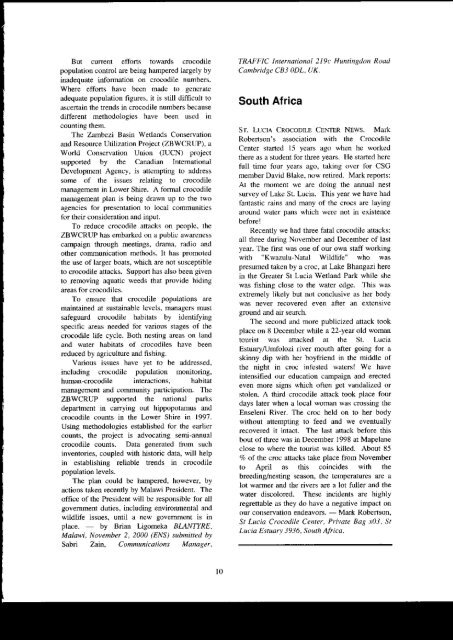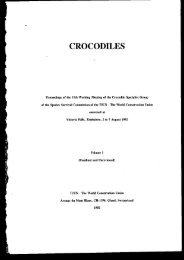size: 1779KB - Crocodile Specialist Group
size: 1779KB - Crocodile Specialist Group
size: 1779KB - Crocodile Specialist Group
You also want an ePaper? Increase the reach of your titles
YUMPU automatically turns print PDFs into web optimized ePapers that Google loves.
But current ellbrts towards crocodile<br />
population contrcl are beirg hampered largely by<br />
inadequate information on crocodile numbers.<br />
Where effons have been made to generate<br />
adequate population tigures, it is still difficult to<br />
anceftain the trends in crocodile numbers because<br />
different methodologies have been uscd in<br />
counting them-<br />
'lhe T.arnbezi Basin wetlands Conservation<br />
and Resource Utilization Project (ZBWCRIIP). a<br />
World Conservation Union (IUCN) project<br />
supported by the Canadian Intemational<br />
Development Agency, is attempting to addrcss<br />
some of the issues relating to crocodile<br />
management in Lower Shire. A fomal crocodile<br />
mafflgement plan is being drawn up to the two<br />
agencies for presentation to local cornmunities<br />
tbr their consideratior and input.<br />
To reduce crocodile attacks on people, the<br />
ZBWCRUP has embrLrked on a public awareness<br />
campaign though meetilgs, drama, radio and<br />
other communication methods. It has p()moted<br />
the use of larger boats, which are not susceptible<br />
to crocodile attacks. Supporl has also been given<br />
to removing aquatic weeds that provide hiding<br />
areas for crocodiles.<br />
To ensure that crocodile populations are<br />
rnaintained at sustainable levels, managers must<br />
safeguard crocodile habitats by identifying<br />
specitic aueas needed for various stages of the<br />
crocodile life cycle. Both nesting areas on land<br />
and water habitats of crocodiles have been<br />
reduced by agriculture and fishing-<br />
Various issues have yet to be addressed,<br />
including crocodile population monitoring,<br />
human-crocodile interactions. habitat<br />
management and community participation, The<br />
ZBWCRUP suppoted the national parks<br />
depadment in canying out hippopotamus and<br />
crocodile counts in the l-ower Shire in 1997.<br />
Using methodotogies established fbr the errlier<br />
counts, the project is advocating semiannual<br />
crocodile counts. Data generated t()m such<br />
inventories, coupled with historic data, will help<br />
in establishing reliable trends in crocodile<br />
population levels.<br />
The plan could be hampered, however, by<br />
actions taken recently by Malawi President. The<br />
offrce of the President will be responsible for all<br />
government duties, including environmental and<br />
wildlife issues, until a new govemment is in<br />
place. -.._ by Brian Ligomeka BLANTYRE.<br />
Malawi, November 2, 2000 (ENS) submitted hy<br />
Sabri Zain, Communications Manager,<br />
TMFFIC I ternationol 2l9c Huntingdort Road<br />
Cambridge CB3 0DL, IIK.<br />
South Africa<br />
S r'. LucrA CRocoDrLE CENTER NEws. Mark<br />
Robedson's association with the <strong>Crocodile</strong><br />
Center started l-5 years ago when he worked<br />
there as a student for th.ree years. He stafied here<br />
full time four years ago, taking over fbr CSG<br />
member David Blake. now retired. Mark reports:<br />
AI the moment we are doing the annual nest<br />
survey of Lake St. Lucia. This year we have had<br />
fantastic rains and many of the crocs are laying<br />
around water pans which were not in existence<br />
betbre !<br />
Recently we had three fatal crocodile attacks;<br />
all three during November and December of last<br />
year. The first was one of our own slaff working<br />
with "Kwazulu-Naral Wildlife" who was<br />
presumed taken by a croc, at Lake Bhangazi here<br />
ir the Greater St Lucia Wetland Park while she<br />
was lishing close to the water edge. This was<br />
extremely likely but not conclusive as her body<br />
was never recovered even after an extensive<br />
ground and air search.<br />
The second and more publicized attack took<br />
place on 8 December while a 22-year old woman<br />
tourist was attacked at the St- Lucia<br />
Estuary,4Jmfolozi river mouth after going for a<br />
skinny dip with her boyfiiend in the middle of<br />
the night in croc infested waters! We have<br />
intensiiied our education campaign and erected<br />
even more signs which often get vandalized or<br />
stolen. A third crocodile attack took place four<br />
days later when a local womiul was crcssing the<br />
Enseleni River. The croc held on to her body<br />
without attempting to feed and we eventually<br />
recovered it intact. The last attack before this<br />
bout of th.ree was in December 1998 at Mapelane<br />
close to where the tourist was killed. About 85<br />
70 of the croc attacks take place from November<br />
to April as this coincides with the<br />
breeding/nesting season, the temperatures are a<br />
lot warmer and the rivers are a lot fuller and the<br />
water discolored. These incidents are highl)'<br />
regrettable as they do have a negative impact on<br />
our conservation endeavors, - Mark Robenson,<br />
St Lucia <strong>Crocodile</strong> Center, Private Bag x03, St<br />
Lucia Estuarl 3936, South Africa.<br />
l0
















